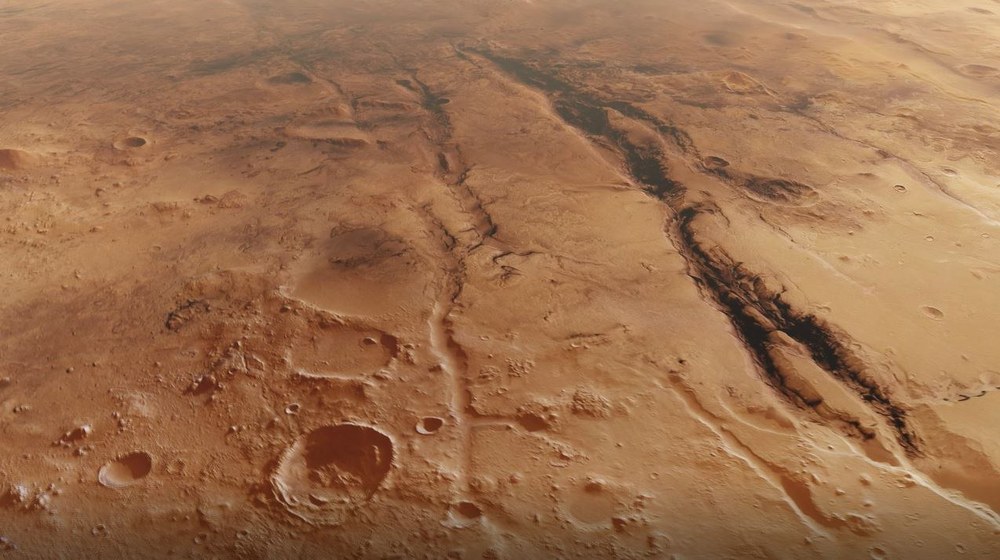Virtual flight around the grabens of Nili Fossae

- This new video was created using the High Resolution Stereo Camera (HRSC) developed by DLR for the Mars Express mission.
- It shows the grabens of Nili Fossae, which extend for several hundred kilometres along the Isidis Planitia impact basin.
- In recent years, observations with spectrometers from orbit have focussed heavily on this area, as a wide variety of minerals have been identified here.
- Focus: Spaceflight, Mars
Nili Fossae is a group of large, concentric grabens located near the Syrtis Major region on Mars. The trenches extend for several hundred kilometres along the northeast side of the Isidis Planitia impact basin. This video was created using data acquired by the High Resolution Stereo Camera (HRSC) developed by the German Aerospace Center (Deutsches Zentrum für Luft- und Raumfahrt; DLR) and built in cooperation with German industrial partners on board the European Space Agency (ESA) Mars Express spacecraft. It is based on a mosaic of images taken by the HRSC from an altitude of approximately 350 kilometres above the surface of the Red Planet.
The film begins with a virtual approach from the south, initially heading north and then turning back towards the south. At the end of the video, you gain altitude and get an overview of the 'Trenches of Nili'. In the final scene, the Jezero crater, a former lake, is visible at the bottom centre, where the Mars 2020 mission has been searching for traces of life with the Perseverance rover since 2021.

A bird's eye view of the Nili trenches
Your consent to the storage of data ('cookies') is required for the playback of this video on Quickchannel.com. You can view and change your current data storage settings at any time under privacy.
ESA/DLR/FU Berlin & NASA/JPL-Caltech/MSSS, CC BY-SA 3.0 IGO
Mineral diversity at the heart of research
The grabens of Nili Fossae stretch for several hundred kilometers along the eastern side of the massive impact basin Isidis Planitia, forming a concentric pattern that runs parallel to the basin's boundary; this suggests that the rifts originated due to tensile tension resulting from settling in the Martian crust after the Isidis impact. After huge, iron-rich, heavy lava deposits pushed the several kilometre-deep basin further down at the boundary between the Martian highlands and lowlands, tensile stresses built up in the Martian crust and led to these extensional fractures. Similar stress cracks were also observed in the Amenthes Fossae, the counterpart of the Nili Fossae, on the opposite south-east side of Isidis Planitia.
In recent years, spectrometer observations from orbit have focused heavily on Nili Fossae due to the wide variety of minerals that have been discovered in this area. These include silicates, carbonates and clay minerals. The originally present, often volcanic minerals have undergone several transformations due to the presence of water throughout the history of Mars and have been weathered into these new mineral groups. It is believed that this water not only flowed over Mars' surface, but was also active, forming hydrothermal solutions below the surface that were heated by volcanic activity.
Image processing
The image mosaic image was combined with topography information from the digital terrain model (DTM) calculated for this area to create a three-dimensional landscape. For every second of the film, 50 individual frames were created digitally, following a predefined scenic camera path. The vertical exaggeration used for the animation is threefold. Atmospheric effects – clouds and haze at a viewing distance of 50 kilometres – were added to conceal the limits of the terrain model. The HRSC mosaics used here are from the HMC30 product family. It comprises large-scale mosaics of DTMs and georeferenced black-and-white and colour images of various regions of Mars.
Link to the HRSC Mars Chart (HMC30) products and detailed description.
(The Nili Fossae region is located in quadrangle MC13E)
Further HRSC products and image strips for download
Related links
The HRSC experiment on Mars Express
The High Resolution Stereo (HRSC) was developed at the German Aerospace Center (DLR) and built in cooperation with industrial partners (EADS Astrium, Lewicki Microelectronic GmbH and Jena-Optronik GmbH). The science team, led by Principal Investigator (PI) Daniela Tirsch from the DLR Institute of Planetary Research, consists of 52 co-investigators from 34 institutions and 11 nations. The camera is operated by the DLR Institute of Planetary Research in Berlin-Adlershof.
